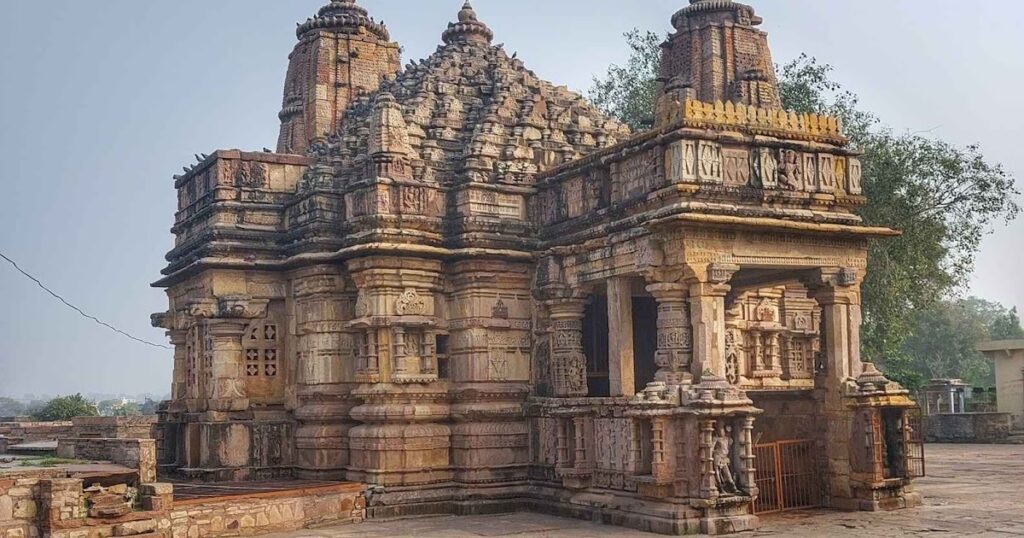Having discovered prehistoric cave paintings in some unimaginable sites and trekking to
the bottom of the valley to pray at the Bhimlat Mahadev Temple situated beside a waterfall
in some fantasyland-like settings, we thought that we had the day. Yet, we were unaware that another hidden treasure waited us: Bijolia, located about 50 km from Bundi on
Chittorgarh Road was the next marvelous spot we were heading to.
Bijolia is a perfectly concealed spot in Bhilwara district of Rajasthan
and hardly anyone in Bundi told of this place. Fortunately, my prior research paid off, and having Sir Om Prakash Kukki with us to unravel the intricacies of this hidden gem was lady luck smiling on us. The Bijolia temples were built around 11th –
13th centuries during the reign of the Chauhan dynasty. Dedicated to God
Shiv, notable temples in the premises are Mahakal Mahadeva
Temple, Hazareshwar Mahadeva Temple and Undeshwar Temple, which is set against
the picturesque backdrop of Mandakini Kund.
Around 3:30 PM as we were reaching the spot, Garh Palace was on one side and exquisitely crafted Bijolia temples came
into view on the other. After Parking the car at small entry gate, we entered into a
different world all together, ready to seek blessings of the Gods and admire the artistic
legacy of the place.
Mahakal Mahadev temple
is the first temple to come across upon entering the premises. It is the oldest
of the three temples dating back to 11th century and here, God Shiv
is worshipped as Mahakala, the Destroyer.
Watch carefully the entry gate of the temple, God Karthikeya and Ganesha are present as the gatekeepers for this temple. This is probably the only Shiv temple, where God Ganesh and Karthikeya are the gatekeepers. Stonecraft of the temple is visible at its best from this angle –
Mahakal Temple has a huge Garbhagriha which leads to inner sanctum which houses a large Shivling and is surrounded by exquisitely carved pillars and mandapas (pillared halls).
A few steps to the right
is the Hazareshwar Temple. Notable is the Natraj carving on the outer wall.
This temple features 1,000 small Shivlings, which are carved
onto the main Shivling. The name “Hazareshwar” comes from
“Hazar” meaning 1,000 and “Eshwar” meaning God, hence the
name “Hazareshwar,” the temple of 1,000 Gods.
Outer walls of the temple stand out for elaborate carvings.
One of the striking features of the Bijolia group of temples is the detailed
and artistic stonework that covers every inch of the structures.
Last temple in the series is the Undeshwar Temple, which stands against the scenic Mandakini Kund. Undeshwar temple was constructed around 1157 AD and has chhatris on its corners.
It is renowned for its beautifully sculpted shikharas and the
finely carved images of various deities that adorn its walls. The temple’s
garbhagriha (sanctum) houses a Shivling, which carries immense significance for
the devotees from across the region.
Shivling in the temple “Garbhagriha”, is approx. 3m below the level of main and
so water from the Mandakini Kund performs “JAL ABHISHEK” and submerges the Shivling with its sacred water at times during the year.
One can find many
interesting carvings on outer walls on Undeshwar Temple. The carvings include
depictions of gods and goddesses and scenes from Hindu epics such as the
Ramayana and the Mahabharata. Carvings are flawless here and not only reflect
the artistic prowess of the craftsmen of that era but also provide valuable
insights into the religious and cultural practices of the time.
In earlier times, temple
sites were not just places of worship; but used to serve as a cultural cradle
where people used to meet, sit around in evenings, celebrate, and thank God for
their lives. Ancient wisdom prioritized water preservation, and many temples
featured stepwells, or Bawdis, within their premises. These ponds or stepwells used
to provide water and respite from scorching heat for both locales and
travelers.
Walking around with these
thoughts, we emerged out of Undeshwar temple and sat around the most splendid spot of
the complex: Mandakini Kund. The Kund is designed like a stepwell where people gather on occasions to take bath in in the sacred waters. Undeshwar Temple in the background creates
a picture-perfect panorama. Temple architecture speaks highly of design prowess of its time, yet the spirit remains truly eternal.
Not to miss here is the
large number of Pigeons or Doves flying around and sitting on the shikhars of all the temples.
This temple complex is
also known as Vijay Mandir. Some inscriptions have been found at the site which
provides valuable information about the rulers of the Chauhan dynasty and their
contributions to the construction and maintenance of these temples. These
inscriptions are an essential source for historians studying the political and
cultural history of Rajasthan during the medieval period.
To summarize, the
Bijolia group of temples stands as a magnificent example of medieval Indian
architecture, rich heritage of Rajputana and religious devotion of the people.
The intricate carvings, grand structures, and historical significance make it a
site to visit that will inspire awe and admiration among the visitors.
Location of Bijolia
temples’ complex:
https://maps.app.goo.gl/uE4jtfVMLpJQQy2J9
Must visit this spot if you are exploring Bundi or even if you are around 150 km. in vicinity of Bijolia. Keep exploring Folks…











